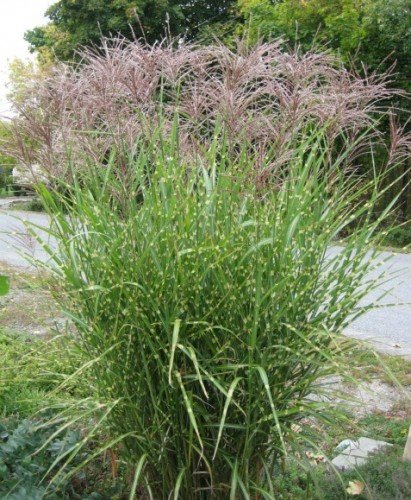These warm weeks of autumn are a good opportunity to renovate the garden and create spaces for new plants next spring. Hidden in that idea is a lot of hard work, digging and dragging! I’ve had strong-arm help from a willing son, and together we’ve been editing the landscape.

First to go was an enormous clump of porcupine grass (Miscanthus sinensis ‘Strictus’, Zone 6). It’s been a terrific statement plant along the front walkway, but has grown to be larger than persons using the path, creating some intimidating moments. Of course I had the design wisdom (cruel joke!) to plant it next to a large granite boulder, just so they could balance each other and make a sympathetic bond. (Oh, the follies we get up to in spring.) Well, it was entirely too close a relationship, for after much hacking off the top and finally reaching the root ball, it was apparent that many roots had gone under the boulder. Truth be told, plants love a rock. But I don’t want to know why this happens, I just want those roots out of there.
If I remember correctly, it took three large men to put that boulder in place, and I don’t own any tool that’s going to move it now. So we did our best to cut and scrape out as many roots as possible, refilled the crater-size hole, and left it at that. I don’t know if the porcupine grass will come back to haunt me, but for now, there’s a big planting space for next spring. Something to dream about through the cold months.
Keeping with the removal theme, we turned to a climbing hydrangea (Hydrangea anomala ssp. petiolaris, Zone 5) that has owned the front façade of our one-storey house for 20 years. That should tell you something about two decades of struggle to keep this big vine confined to a 10- by 10-foot (3- by 3-m) space. (It’s the better part of discretion not to ask why I planted this vine in such a small venue.) Climbing hydrangea is a woody vine that’s slow to establish, but after a demure performance for the first five years, it begins to make moves to reach an ultimate goal of 60 feet (18 m)! I have no doubt it would have run across the roof and come down on the back deck. I like big plants, but there is a line between big and too big.
Climbing hydrangea clings with a powerful grip to any flat surface by extending short, root-like holdfasts. Getting the vine off the brick wall was exhausting enough, but then there was the matter of the root ball. After much rocking the thing back and forth and displacing many hellebores and ferns growing in the bed, it was finally out. The wall still carries quite a lot of gripper roots that need to be scrapped off with a wire brush, but I’ll let the winter elements work on them before attempting the job. And by the way, I have two more climbing hydrangea vines. Yes, you read that correctly!
Other posts by Judith this week:
Posts from Judith last week:









Hi Tracy: Climbing hydrangea normally don’t flower for the first 5 years or so – the roots are getting established in the meantime. Don’t worry about it – it will come – just give it a little time!
Dorothy
Hi Tracey (Oct. 12),
That’s a lovely way to use climbing hydrangea, and I’m sure you’ll enjoy it for many years. Your vine will possibly bloom next year. The flowers are carried on lateral wood that extends 24 inches (60 cm) from the supporting surface, and it takes about two years for the lateral branches to develop. Control will be an issue, but not so difficult to keep up with, as you have the vine growing around the pond, and not on a potentially high wall. Climbing hydrangea will work as a groundcover, and you may find that useful. Hope for flowers next spring!
— Judith
Hi Virginia (Oct. 12),
Climbing hydrangea really loves a stone wall — and you have two! The easiest way to control the spread of the vines is to remove the new, current season runners as they expand along the wall surface. This youngest wood grows in summer, and next year will begin developing lateral branches extending outward that will eventually carry flowers. It’s easy to pull the new wood off the wall before the gripper roots harden. Do it now!
— Judith
I planted a climbing hydrangea at the side of my raised pond two years ago and although it is growing nicely, it hasn’t bloomed or gotten out of control. I wish it would, as the reason I planted it was to soften the hard edges of my pond and give it a timeworn look! I may rue that decision yet, but I really love the look of the vine.
I have two climbing hydrangea, both on stone walls. I noticed their tendency to escape this summer. What do you suggest—extensive surgery in the fall or after the spring bloom, to keep them in some sort of control? By the way, they are growing in my backyard in Lindsay, Ont., where the weather sometimes dips into Zone 4 territory, and bloom beautifully.